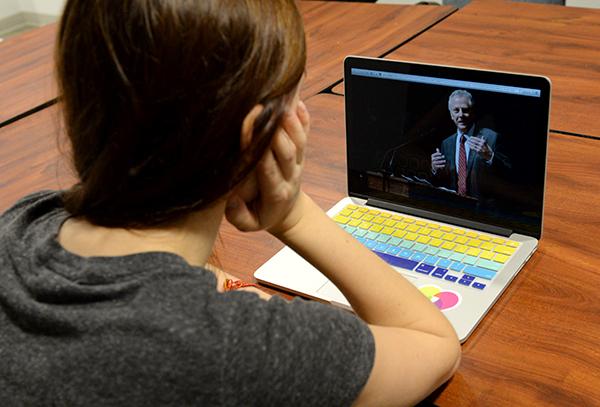After associate marketing professor Vanessa Perry started teaching an online course for the School of Business, she decided her on-campus students could also benefit from hearing lectures at home.
Perry began to require students to complete interactive exercises online before class so she could spend less time lecturing and more time working with them.
She has shifted toward using what’s known as a flipped classroom model, in which students prepare for class by watching videos and reading articles. Class time is then used for discussion, group activities and one-on-one work with the professor.
“Traditional lectures are one of the worst ways to convey information,” Perry said. “It’s better to use that time again for the kinds of activities that benefit from there being all these people in the room.”
More professors at GW have started using flipped classroom teaching as a way to better engage students during scheduled class times. Perry said it would be “ideal” for students to watch videos that highlight key themes and concepts before class, but professors first have to create videos that will keep their attention.
Not only does that involve the technical process of recording and uploading, as well as ensuring students can watch them, but professors have to know how to best organize the videos, she said.
“You can’t just sit in front of your computer and talk for 45 minutes and record it on a still camera and expect students to watch that,” Perry said. “You have to think about how can I break this up into meaningful sections.”
Patricia Dinneen, director of the University Teaching and Learning Center, said the center offers at least one workshop each semester to help faculty learn about the flipped-classroom style, and works individually with professors who are looking to prepare materials to make the shift.
Dinneen said more teachers have shown interest in the process as technology has improved and made it easier for them to incorporate online learning methods into their classes.
Offering a lecture before class gives faculty more options for how they will spend class time, she said, and she’s seen interest in the model across GW’s schools.
“We really don’t believe in a one-size-fits-all approach for faculty,” Dinneen said. “We encourage faculty to explore all kinds of approaches based on defining what it is they’d like to accomplish in their classroom.”
The flipped classroom model has gained some popularity at colleges across the country as more professors have integrated technology into their lesson plans. After the TED organization created TED-Ed, a website that lets teachers create custom educational videos, more teachers started jumping on the idea of using class time for group work and personal tutoring.
The University has put more of a focus on shifting academic programs online to recruit more students from outside the D.C. area, especially in graduate programs. The provost’s office launched an eDesign Shop last summer so professors could more easily create online programs without the help of outside consultants.
Lorena Barba, an associate professor of mechanical engineering, started to use the flipped classroom model before she came to GW just over a year ago. She said students are more likely to make discoveries about a particular topic on their own, which might make them more excited about the subject matter.
“I see students more engaged with the course and reaching a deeper understanding,” she said. “It also creates a collaborative environment that provides a social fabric to support learning and persevering through difficult parts of a course.”
When she first flipped her classroom, Barba asked students to watch pre-recorded videos of lectures, though videos aren’t the only way to have students prepare for class, she said.
Barba said she was one of the first in higher education to use the model, but it has become more popular in the last three years, especially in STEM – science, technology, engineering and math – fields.
Laura Hill Bermingham, a professor of biology at the University of Vermont, works with the school’s teaching and learning center to show professors how to lead a flipped classroom. She said students typically complete pre-assignments, which gives her the chance to clear up misconceptions about a topic early during class time.
“The time that we actually spend together as me being the teacher and them being the students is very small. It’s a more effective way of teaching if I know what they know and I know what they don’t know,” she said.
Sharon Lynch, a professor of curriculum and pedagogy in the Graduate School of Education and Human Development, said she has always tried to create a more active classroom, so the students she was training to be teachers would steer away from lectures, too.
The school’s small class sizes lend themselves to more interactive classes as well, Lynch said. With a few exceptions, lectures have been proven to not be the best way to teach a class.
“The research is almost overwhelming that the lecture method usually doesn’t attract the majority of kids. It doesn’t engage them, they are not inspired by it,” she said.







